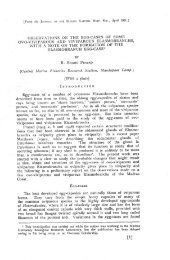PDF - Eprints@CMFRI
PDF - Eprints@CMFRI
PDF - Eprints@CMFRI
Create successful ePaper yourself
Turn your PDF publications into a flip-book with our unique Google optimized e-Paper software.
132<br />
This species is represented by two specimens among the material we examined from Red Sea. One is<br />
massive, the other encrusting. Corallites polygonal, calices polygonal or oval , when the walls are thickened.<br />
Greater diameter (length) of calices 2 to 3.5 mm , wall thickened up to 1 mm with a conspicuous intercorallite<br />
groove in the middle. Septa in three cycles, the first two cycles join the columella ; all septa<br />
exsert, slightly swollen at the theca, at first sloping and then vertically descending; edges mostly entire or<br />
with microscopic serrations; sides granular. Columella composed of vertical papillary structures that are<br />
arranged in a line alo ng the middle of the long axis of the calices forming a partition to either ends of<br />
which the two directive septa of the first cycle unite.<br />
Mate r ial ,<br />
Gulf of Aqaba , Basel PW 7 3 631a (Dahab, 20- 22 m, encrusting on a Goniastrea peetinata).<br />
Central R. S.: HLM RM 94 (Wingate R. ).<br />
Dis t rib uti 0 n: A common and widespread species from Red Sea to Tahiti. Often found in all<br />
localities where L. purpurea occurs.<br />
A Slrea<br />
Leptastrta<br />
Leptastrea purpurea (DANA), 1846<br />
(PIa[!! 31 , F igs. 11. 12)<br />
purpurea 1846. DANA, 23 9; pl . 12110a-c (Type locality; Fiji),<br />
purpurea 1918, VAUG HAN . 91; pl. 30/ 1-3 (synonymy),<br />
1948, CROSSLAND. 184 (var. roissyana).<br />
1952. CROSSLAND. 115 , pis. 115 , l/l.<br />
1971. LOYA & SLOBODKIN. 124.<br />
1975 . CHEVALIER, 37 ; pis. 213, 4 ; 3/2; 37/ 11 , 12 ; 38/1-2;42/6 (syno nymy).<br />
1977. VERON. PI CHON & WljSMAN·BEST. 158 , figs. lOl- l 10. 467.<br />
1980, HEAD, 152. 461.<br />
1980, WIJSMAN-BEST, 248 ; pI. 1/ 1. 2 (synonymy).<br />
ebrenbergana 1857, MILNE EDWARDS (& HAIME). 494; pI. 07/ 4 (Type locality: Red Sea).<br />
1888, ORTMANN, 175.<br />
1914 , MATTHAI. 68; pis. 17/ 5, 6; 18/ 2, 7; 19/3 , 4 ; 1418 (synonymy).<br />
1952. CROSSLAND, IlS;pls. 115 ; 3/ 3.<br />
pruinoSD 1952, CROSSLAND, 116 , pI. l i l.<br />
There are three specimens of this species among the material we received from US M, two from Gulf of<br />
Aqaba and two from the old collection of HLM . These speci mens are in general agreement with MATTHAI's<br />
description of L. ehrenbergana.<br />
Mate ri al:<br />
Gulf of Aqaba:<br />
Northern R. S.:<br />
T. Aviv<br />
USNM<br />
HLM<br />
S<br />
Wa<br />
EC<br />
4977 (Dahab); 4861 (Ras Atantur).<br />
76, 77 , 78 (G hardaqa).<br />
70,74 (Koseir, duplicates from KLUNZINGER, the latter labelled<br />
L. ehrenbergiana).<br />
Dis t rib uti 0 n : Wide-spread from Red Sea to Hawaii.<br />
Rem a rk s : SCHEER & PI LLAI (1974) have pointed out the difficulties in separating specimens of<br />
L. transversa and L. purpurea in some cases. It has also been noticed by PILLAI (unpub!.) from South<br />
Indian reefs that in some coralla both purpurea and transversa conditions may coexist at different parts.<br />
Their major distinction lies in the dentation of the septa and in the nature of the columella. All the<br />
authors since MATTHAI (1914) have told these two species separate. However, it is with hesitation that<br />
we separate them. L. transversa could very well be a skeletal form of L. purpurea.<br />
The ty pe of L. pruinosa CROSSLAND in BMNH is a minute colony. Both CHEVALIER (1975) and<br />
VERON et. al. ( 1977) had many specimens which these authors assign to L. pruinosa. According to VERON,<br />
PICHON & WljSMAN-BEST "This species is as difficult to differentiate from L. purpurea as the latter is<br />
form L. transversa" (p. 165). However, they differentiate them on the basis of behaviour and colouration<br />
of polyps. After a study of the type of L. pruinosa PI LLAI, STODDART & MORTEN (unpub!') felt that it<br />
is the same as L. purpurea.
















